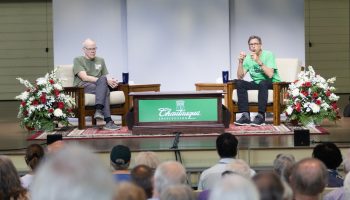
Mariia Novoselia
Staff writer
Nicholas Moy sees birds as great conversation starters about biodiversity.
“Everyone loves birds,” he said.
Conservation science program manager at the National Parks Conservation Association, Moy uses data to tell stories about national parks, and to detect and foresee conservation threats. Titled “National Park Landscapes and the Sixth Extinction,” his lecture for the Chautauqua Science Group is at 9:15 a.m. today in the Hurlbut Church Sanctuary, organized in collaboration with the Chautauqua Climate Change Initiative.
Moy said what led him to a career in conservation was his interest in ornithology and avian ecology.
The red-cockaded woodpecker has been on his mind a lot lately.
Red-cockaded woodpeckers, he said, are directly connected to the longleaf pine ecosystem spread across the southeastern United States from Georgia to Texas. Logging of the pine system, Moy said, has resulted in a significant loss of many red-cockaded woodpeckers and prompted efforts to re-include them in Big Thicket National Preserve outside of Houston, Texas.
Not only are birds like the red-cockaded woodpeckers extremely important for the ecosystem, but they can also serve as huge economic drivers in areas of their habitat with people traveling to see them, Moy said.
Birds and national parks, he said, share several similarities – people getting excited about both of them is one.
“(National parks) are places that we all go to, and we feel wonder. … (They) have a really important place in people’s psyche and in their everyday lives,” Moy said.
Growing up in the Midwest, he said he didn’t have a lot of opportunities to visit national parks, but the first he ever did was the Great Smoky Mountains.
“I remember thinking, ‘This is what real wilderness feels like, this is what real nature feels like,’ ” he said, noting that he had previously been to Indiana Dunes, which at the time was not considered a national park yet.
In times of a sixth mass extinction that comes as a result of “human-caused disturbances,” he said many researchers are trying to figure out how to solve the problem and what tools to use.
The fifth mass extinction occurred 65.5 million years ago and wiped out the dinosaurs, according to the World Wildlife Fund.
Moy said he and his team use geographic information systems, or GIS, for a variety of projects, like monitoring where elk go when they leave Yellowstone or what national parks people tend to visit more.
One of the solutions currently being worked on was proposed by biologist and ecologist E. O. Wilson in his book Half-Earth. The idea, Moy said, is that humans need to protect 50% of all lands and waters in order to save 80 to 85% of biodiversity.
While most people, he said, think of national parks as “best examples of what nature could look like without (human) disturbance,” national parks are not enough to protect all species. They need landscapes around them, he said.
“We’ve learned over the past decades that setting aside small pieces of land for protection leaves them vulnerable. Large, connected landscapes are much healthier (and) much more resilient,” Moy said.
Industrial revolution, climate change and water and air pollution only amplify the problem, he said.
The United Nations, Moy said, has taken up Wilson’s idea and set a shorter goal: to protect 30% of the world by 2030. In 2021, President Joe Biden issued the “Tackling the Climate Crisis at Home and Abroad” executive order, calling the conservation of 30% of U.S. land, freshwater and ocean areas by 2030.
National parks, Moy said, are “a star child in motivating other conservation (initiatives) outside of national parks” and can “play a large role in getting people excited about protecting half of the planet by 2050.”
Moy said conservation is crucial for human existence.
“It sounds bleak, but it’s also exciting and motivating. The science is clear that we need the ecosystems around us to survive – there’s no world where we engineer an environment that can sustain humans into the extended future,” he said. “We are these soft, fragile creatures in so many ways, and we forget often that we have to rely on pollinators, we rely on trees for oxygen. … We will see a much more dire future if we’re not protecting large amounts of species very quickly.”




